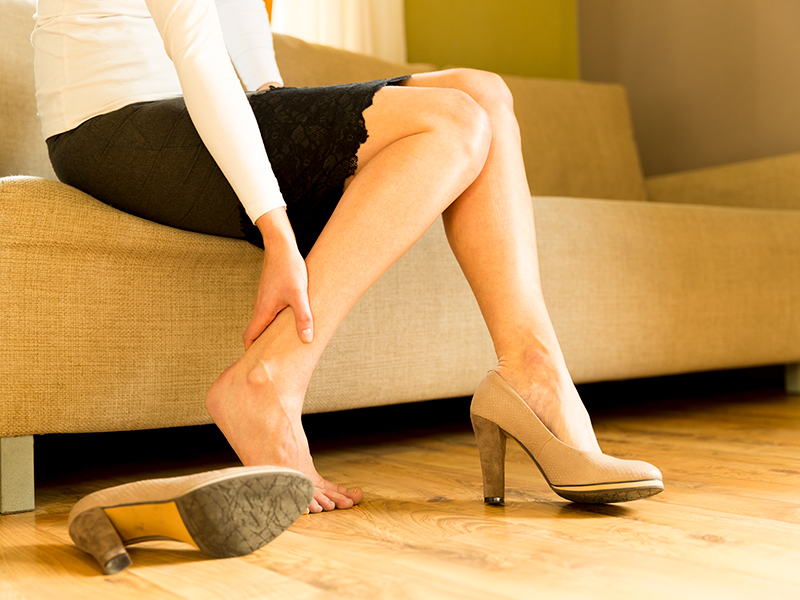Varicose veins are enlarged, twisted veins. They can happen anywhere in the body. But they are more common in the legs.
While this is not considered a serious health problem, it can be uncomfortable and lead to more serious issues. And because they may be very noticeable, they may cause people to feel uncomfortable or embarrassed.
Spider veins, a milder type of varicose veins, are smaller and often look like a sunburst or spider web. They are red or blue in color and are often found on the face and legs, just under the skin.
What causes varicose veins?
Increased blood pressure in the veins causes varicose veins. They can occur in the veins near the surface of the skin.
“Our blood moves toward the heart by one-way valves in our veins. When those valves become weakened or damaged, blood can collect in the veins causing veins to enlarge. This results in varicose veins that can be unsightly and uncomfortable,” said Dr. Warren Albrecht, Sanford Health vascular surgeon in Fargo, North Dakota.
Who is at risk?
Sitting or standing for long periods of time can cause blood to pool in the leg veins. Other factors can increase pressure on the veins, including:
- Being overweight
- Age
- Being female
- Inactivity
- Leg injuries
- Pregnancy
- Smoking
- Heredity
“If people are concerned about the appearance of their veins or start to experience pain, they should see a doctor to evaluate what type of treatment is best for their condition,” said Dr. Daniel Tarver, an interventional radiologist at Sanford Bismarck.
Schedule an appointment: Find a Sanford vascular specialist near you
What can I do to prevent varicose veins?
There are several things you can do to manage varicose veins. They include:
- Taking frequent breaks from standing or sitting for long periods
- Elevating your legs when possible
- Exercising to promote better circulation and lose excess weight
- Wearing low-heeled shoes
Some recommendations suggest that crossing your legs when you sit can cause varicose veins. “That’s usually an old wives’ tale which is not proven,” Dr. Albrecht said.
“Treatments can range from compression socks, creams and medications, to surgery that closes or removes the veins. An ultrasound can help identify which veins are causing symptoms,” said Dr. Tarver.
What are the symptoms?
The most common symptoms are:
- Color changes in the skin
- Sores on the legs (leg ulcers)
- Rash
- Sensations in the legs, such as a heavy feeling, burning or aching
Over time, severe cases may lead to long-term mild swelling. That can result in more serious skin and tissue problems. These include ulcers and nonhealing sores.
The symptoms of varicose veins may look like other health problems. Always talk with your health care provider for a diagnosis.
How are varicose veins diagnosed?
Your health care provider will ask about your health history and do a physical exam. You may also need a duplex ultrasound. This test is a type of ultrasound that checks blood flow and the structure of the leg veins. Duplex means two kinds of ultrasound are used.
How are they treated?
Treatment will depend on your symptoms, age and general health. It will also depend on how severe the condition is.
If you don’t have symptoms, you may not need treatment. But varicose veins may sometimes get worse without treatment. If you need treatment, it may include:
- Leg elevation. You may be instructed to elevate your feet above your heart three or four times a day for about 15 minutes at a time. If you need to sit or stand for a long time, flexing your legs now and then can help keep blood circulating. If you have mild to moderate varicose veins, elevating your legs can help reduce leg swelling and ease other symptoms.
- Compression stockings. These elastic stockings squeeze the veins and prevent blood from pooling. They can be effective if you wear them every day.
- Sclerotherapy. This is the most common treatment. A chemical injected into the affected veins causes scarring so they can no longer carry blood. Blood then returns to the heart through other veins while the body absorbs the scarred veins.
- Endovenous laser ablation or radiofrequency ablation (RFA). This is a minimally invasive procedure. A tube (catheter) puts heat right into the affected vein. This closes the vein. Once the vein is closed, less blood pools in the leg which improves overall blood flow.
- Vein stripping. In more severe cases, the surgeon may tie off and remove veins by making small cuts in the skin.
- Microphlebectomy. Special tools inserted through small incisions are used to remove varicose veins. It may be done in your health care provider’s office, either alone or with vein stripping.
What are possible complications?
Varicose veins are often not serious. But complications may happen. They include:
- Inflammation or swelling of veins (phlebitis)
- Blood clots
- Pulmonary embolism (when a piece of a blood clot may break off and travel to the lungs)
Learn more
…
Posted In Bismarck, Fargo, Healthy Living, Vascular, Women's, Workplace Health
